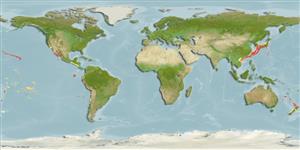Actinopterygii (ray-finned fishes) >
Anguilliformes (Eels and morays) >
Muraenidae (Moray eels) > Muraeninae
Etymology: Gymnothorax: Greek, gymnos = naked + Greek, thorax, -akos = breast (Ref. 45335); ypsilon: ypsilon after the 20th letter of the Greek alphabet, in reference to the Y-shaped dark bars often found on this species (Ref. 10659). More on author: Randall.
Environment / Climate / Range
Ecology
Marine; demersal; depth range 120 - 185 m (Ref. 58302). Subtropical, preferred ?
Pacific Ocean: southern Japan and the Hawaiian Islands.
Size / Weight / Age
Maturity: Lm ? range ? - ? cm
Max length : 89.0 cm TL male/unsexed; (Ref. 35990); 77.6 cm TL (female)
Short description
Morphology | Morphometrics
Anal
spines: 0;
Anal
soft rays: 151 - 154;
Vertebrae: 141 - 153. A species of Gymnothorax of moderate length. Dorsal fin moderately high, its origin before gill opening. Anus before mid-body. Jaw teeth sharp and uniserial. Body creamy light brown with 26-35 distinct, narrow, dark crossbars extending onto fins (some bars on most specimens Y-shaped). Anterior part of head uniformly light brown. Anal fin with a white margin (Ref. 10659). MVF 5-56-149 (Ref. 35990).
Life cycle and mating behavior
Maturity | Reproduction | Spawning | Eggs | Fecundity | Larvae
Böhlke, E.B. and J.E. Randall, 2000. A review of the moray eels (Anguilliformes: Muraenidae) of the Hawaiian Islands, with descriptions of two new species. Proc. Acad. Nat. Sci. Philad. 150:203-278. (Ref. 35990)
IUCN Red List Status (Ref. 115185)
CITES (Ref. 94142)
Not Evaluated
Threat to humans
Harmless
Human uses
More information
Common namesSynonymsMetabolismPredatorsEcotoxicologyReproductionMaturitySpawningFecundityEggsEgg development
Age/SizeGrowthLength-weightLength-lengthLength-frequenciesMorphometricsMorphologyLarvaeLarval dynamicsRecruitmentAbundance
ReferencesAquacultureAquaculture profileStrainsGeneticsAllele frequenciesHeritabilityDiseasesProcessingMass conversion
Tools
Special reports
Download XML
Internet sources
Estimates of some properties based on models
Phylogenetic diversity index (Ref.
82805): PD
50 = 0.5000 [Uniqueness, from 0.5 = low to 2.0 = high].
Bayesian length-weight: a=0.00095 (0.00047 - 0.00196), b=3.10 (2.93 - 3.27), in cm Total Length, based on LWR estimates for this Genus-body shape (Ref.
93245).
Trophic Level (Ref.
69278): 4.1 ±0.7 se; Based on size and trophs of closest relatives
Resilience (Ref.
69278): Low, minimum population doubling time 4.5 - 14 years (Preliminary K or Fecundity.).
Vulnerability (Ref.
59153): High vulnerability (57 of 100) .
